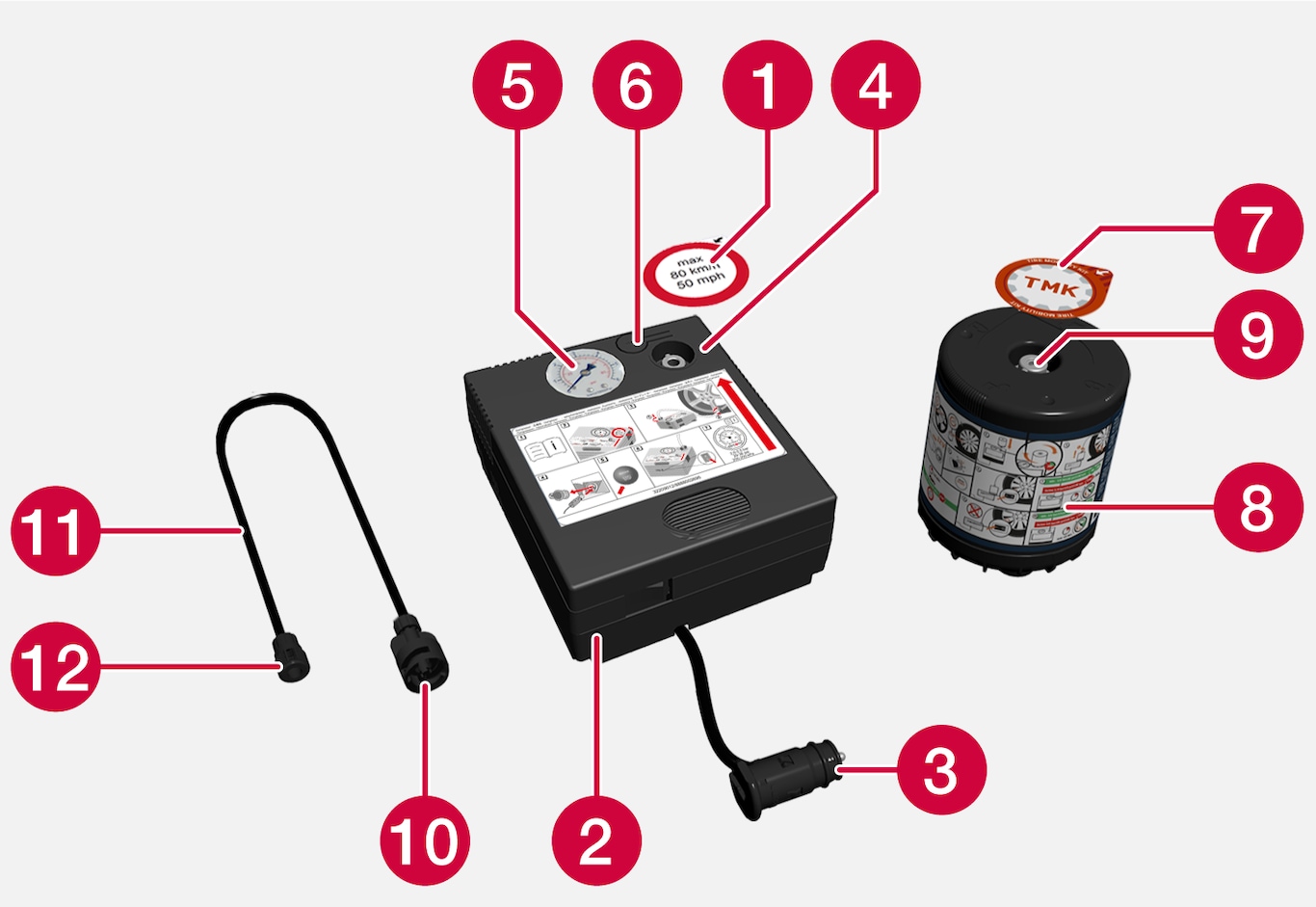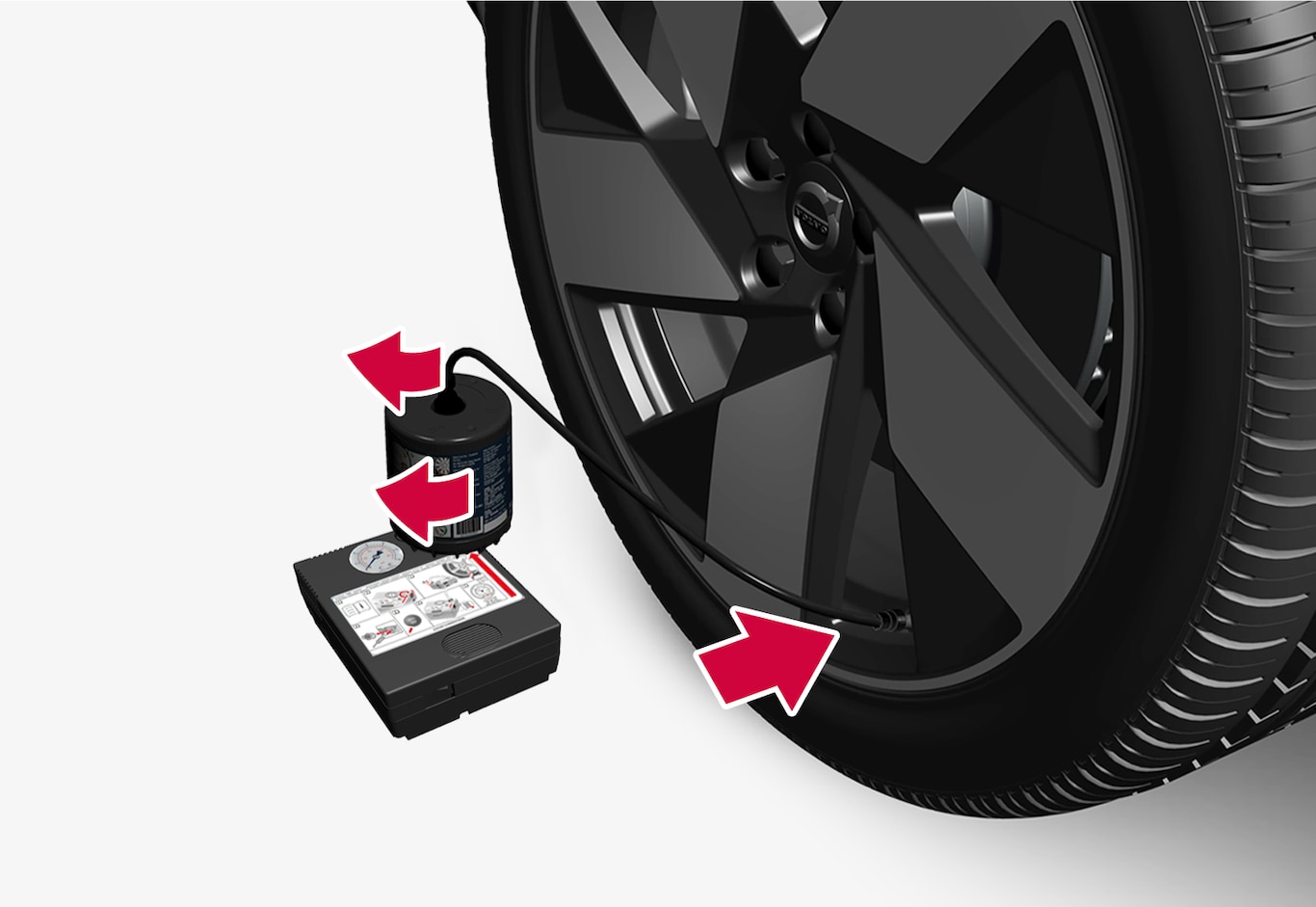Using the tire sealing system
Overview

 Speed limit sticker
Speed limit sticker Switch
Switch Electrical cable
Electrical cable Bottle holder
Bottle holder Air pressure gauge
Air pressure gauge Air release valve
Air release valve Decal, wheel-side warning
Decal, wheel-side warning Sealing compound bottle
Sealing compound bottle Bottle opening
Bottle opening Connection for bottle
Connection for bottle Hose
Hose Connection valve
Connection valve
Connecting

Warning
- The sealing compound bottle contains natural rubber latex. These substances are harmful if swallowed.
- The contents of this bottle may cause allergic skin reactions or otherwise be potentially harmful to the respiratory tract, the skin, the central nervous system, and the eyes.
- Keep out of reach of children.
- Do not ingest the contents.
- Avoid prolonged or repeated contact with the skin. Remove any clothing that has come into contact with sealant.
- Wash thoroughly after handling.
- Skin: Wash affected areas of the skin with soap and water. Get medical attention if symptoms occur.
- Eyes: Flush with plenty of water for least 15 minutes, occasionally lifting the upper and lower eyelids. Get medical attention if symptoms occur.
- Inhalation: Move the exposed person to fresh air. If irritation persists, get medical attention.
- Ingestion: Get medical attention.
- Disposal: Dispose of this material and its container at a hazardous or special waste collection point. Always follow federal and local environmental regulations.
Warning
Preparations
Turn on the vehicle's hazard warning flashers if the tire sealing system is to be used in an area with traffic.
If the puncture was caused by a nail or similar object, do not remove it. It will help seal the hole.
Peel off the speed limit sticker from the side of the compressor. Affix the decal to a clearly visible location on the windshield to remind the driver not to exceed this speed limit. Do not drive faster than 80 km/h (50 mph) while using a tire that has been temporarily repaired with the tire sealing system.
Also peel off the warning decal and affix it securely to the side of the wheel.
Attach the sealing compound bottle to the compressor and then turn clockwise 90 degrees.
The bottle is equipped with a check valve that prevents fluid leakage when the bottle is not connected to the compressor.
Unscrew the tire's valve cap and screw the hose's valve connector as far as possible onto the valve.
Begin tire sealing procedure
Connect the electrical cable to the nearest 12 V outlet and start the vehicle.
Note
Warning
Warning
Start the compressor by moving the switch to the I (On) position.
When the compressor starts, the pressure can increase up to 6 bar (88 psi), but the pressure will decrease after approx. 30 seconds.
Warning
Important
Switch off the compressor and check the inflation pressure using the air pressure gauge. The inflation pressure should be between 1.8 bar (26 psi) and 2.5 bar (36 psi). If the inflation pressure is too high, use the air release valve to release air.
- Remove the hose from the tire's valve.
- Remove the hose from the bottle.
- Remove the bottle from the compressor.
- Reconnect the hose directly to the compressor.
- Screw the hose back on to the tire's valve.
- Release air by pressing the air release valve.
Warning
Note
- After inflating a tire, always replace the valve cap to help prevent valve damage caused by gravel, dirt, etc.
- Use plastic valve caps only. Metal caps could corrode and become difficult to remove.
Clean the hose before stowing it and make sure that no sealing compound is leaking out.
Warning
Rechecking the inflation pressure
Connect the hose to the tire's valve and screw the hose connector onto the valve as far as possible. The compressor must be switched off.
Check the inflation pressure on the air pressure gauge.
- If the pressure is under 1.3 bar (19 psi), the tire is not sufficiently sealed. The vehicle should not be driven. Call roadside assistance to have the vehicle towed.
- If the inflation pressure is higher than 1.3 bar (19 psi), the tire must be inflated to the inflation pressure specified on the tire pressure decal on the driver's side door pillar (1 bar = 100 kPa = 14.5 psi). If the inflation pressure is too high, use the air release valve to release air.
Warning
Volvo recommends driving to the nearest authorized Volvo workshop to have the tire replaced/repaired. Inform the workshop that the tire contains sealing compound.
The sealing compound bottle and the hose must be replaced after use. Volvo recommends contacting an authorized Volvo workshop for replacement.